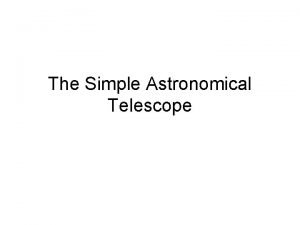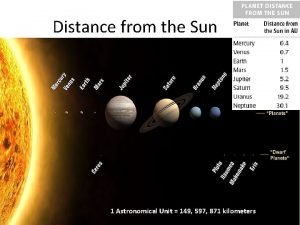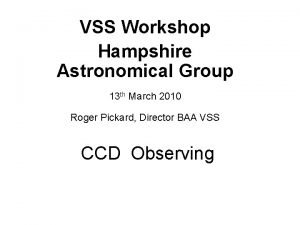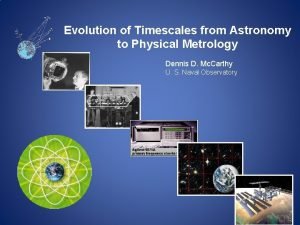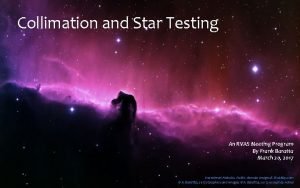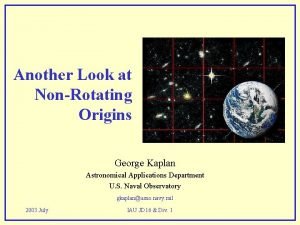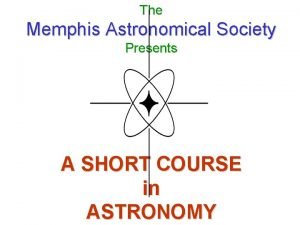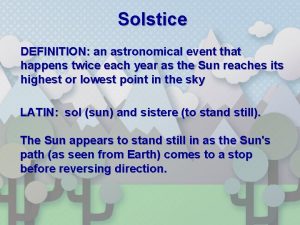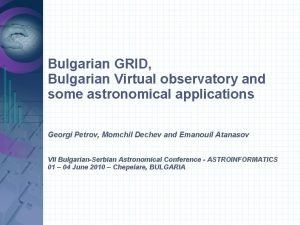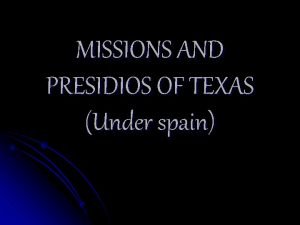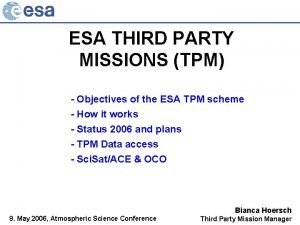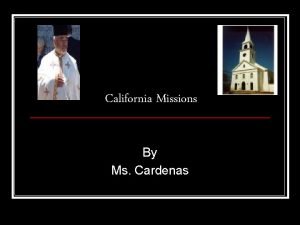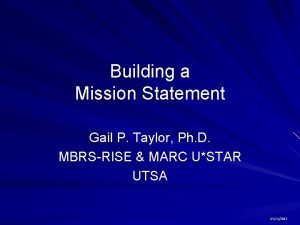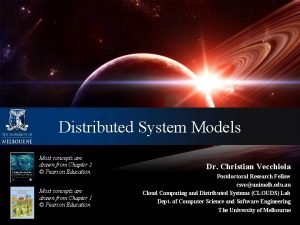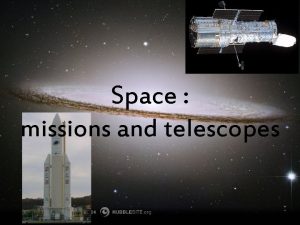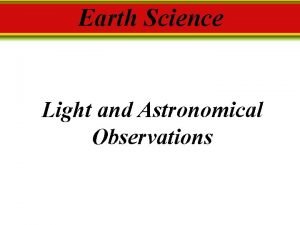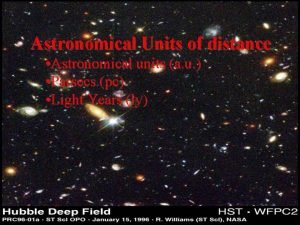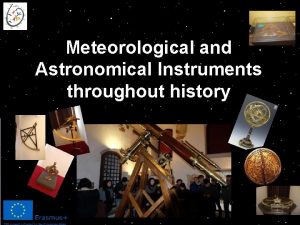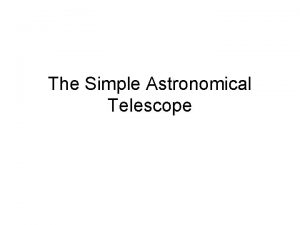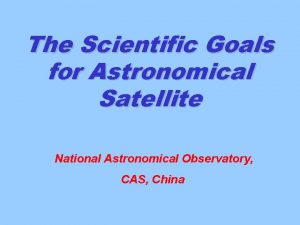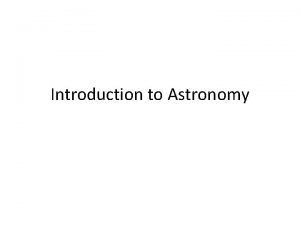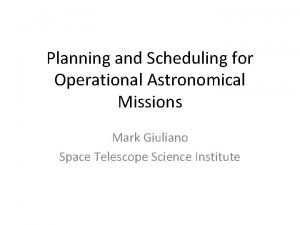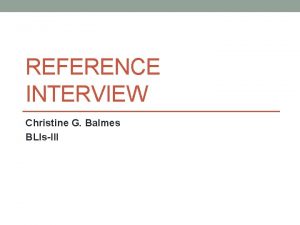The fundamental astronomical reference systems for space missions


































- Slides: 34

The fundamental astronomical reference systems for space missions and the expansion of the universe Michael Soffel & Sergei Klioner TU Dresden

IAU-2000 Resolution B 1. 3 Definition of BCRS (t, x) with t = x 0 = TCB, spatial coordinates x and metric tensor g Ä post-Newtonian metric in harmonic coordinates determined by potentials w, w i

IAU -2000 Resolutions: BCRS (t, x) with metric tensor

Equations of translational motion • The equations of translational motion (e. g. of a satellite) in the BCRS • The equations coincide with the well-known Einstein-Infeld-Hoffmann (EIH) equations in the corresponding point-mass limit Le. Verrier

Geocentric Celestial Reference System The GCRS is adopted by the International Astronomical Union (2000) to model physical processes in the vicinity of the Earth: A: The gravitational field of external bodies is represented only in the form of a relativistic tidal potential. B: The internal gravitational field of the Earth coincides with the gravitational field of a corresponding isolated Earth. internal + inertial + tidal external potentials

Local reference system of an observer The version of the GCRS for a massless observer: A: The gravitational field of external bodies is represented only in the form of a relativistic tidal potential. observer internal + inertial + tidal external potentials • Modelling of any local phenomena: observation, attitude, local physics (if necessary)

BCRS-metric is asymptotically flat; ignores cosmological effects, fine for the solar-system dynamics and local geometrical optics

One might continue with a hierarchy of systems • GCRS (geocentric celestial reference system) • BCRS (barycentric) • Ga. CRS (galactic) • Lo. Gr. CRS (local group) etc. each systems contains tidal forces due to system below; dynamical time scales grow if we go down the list -> renormalization of constants (sec- aber) BUT: expansion of the universe has to be taken into account

BCRS for a non-isolated system Tidal forces from the next 100 stars: their quadrupole moment can be represented by two fictitious bodies: Body 1 Body 2 Mass 1. 67 Msun 0. 19 MSun Distance 1 pc 221. 56° 285. 11° -60. 92° 13. 91°

The cosmological principle (CP): on very large scales the universe is homogeneous and isotropic The Robertson-Walker metric follows from the CP

Consequences of the RW-metric for astrometry: - cosmic redshift - various distances that differ from each other: parallax distance luminosity distance angular diameter distance proper motion distance

Is the CP valid? • Clearly for the dark (vacuum) energy • For ordinary matter: likely on very large scales

solar-system: 2 x 10 -10 Mpc : our galaxy: 0. 03 Mpc the local group: 1 - 3 Mpc

The local supercluster: 20 - 30 Mpc

dimensions of great wall: 150 x 70 x 5 Mpc distance 100 Mpc

Anisotropies in the CMBR WMAP-data

/ < 10 -4 for R > 1000 (Mpc/h) (O. Lahav, 2000)

The CP for ordinary matter seems to be valid for scales R > R inhom with R inhom 400 h -1 Mpc

The WMAP-data leads to the present (cosmological) standard model: Age(universe) = 13. 7 billion years Lum = 0. 04 dark = 0. 23 = 0. 73 (dark vacuum energy) H 0 = (71 +/- 4) km/s/Mpc


In a first step we considered only the effect of the vacuum energy (the cosmological constant ) !


(local Schwarzschild-de Sitter)

The -terms lead to a cosmic tidal acceleration in the BCRS proportial to barycentric distance r effects for the solar-system: completely negligible only at cosmic distances, i. e. for objects with non-vanishing cosmic redshift they play a role

Further studies: - transformation of the RW-metric to ‚local coordinates‘ - construction of a local metric for a barycenter in motion w. r. t. the cosmic energy distribution - cosmic effects: orders of magnitude

According to the Equivalence Principle local Minkowski coordinates exist everywhere take x = 0 (geodesic) as origin of a local Minkowskian system without terms from local physics we can transform the RW-metric to:

Transformation of the RW-metric to ‚local coordinates‘

‘ Construction of a local metric for a barycenter in motion w. r. t. the cosmic energy distribution

Cosmic effects: orders of magnitude • Quasi-Newtonian cosmic tidal acceleration at Pluto‘s orbit 2 x 10**(-23) m/s**2 away from Sun (Pioneer anomaly: 8. 7 x 10**(-10) m/s**2 towards Sun) • perturbations of planetary osculating elements: e. g. , perihelion prec of Pluto‘s orbit: 10**(-5) microas/cen • 4 -acceleration of barycenter due to motion of solar-system in the g-field of -Cen solar-system in the g-field of the Milky-Way in the g-field of the Virgo cluster < 10**(-19) m/s**2

The problem of ‚ordinary cosmic matter‘ The local expansion hypothesis: the cosmic expansion occurs on all length scales, i. e. , also locally If true: how does the expansion influence local physics ? question has a very long history (Mc. Vittie 1933; Järnefelt 1940, 1942; Dicke et al. , 1964; Gautreau 1984; Cooperstock et al. , 1998)

The local expansion hypothesis: the cosmic expansion induced by ordinary (visible and dark) matter occurs on all length scales, i. e. , also locally Is that true? Obviously this is true for the -part

Validity of the local expansion hypothesis: unclear The Einstein-Straus solution ( = 0) LEH might be wrong

Conclusions If one is interested in cosmology, position vectors or radial coordinates of remote objects (e. g. , quasars) the present BCRS is not sufficient the expansion of the universe has to be considered modification of the BCRS and matching to the cosmic R-W metric becomes necessary

THE END
 What is angular magnification
What is angular magnification Sc002 constellation chart
Sc002 constellation chart When it winter
When it winter Hampshire astronomical group
Hampshire astronomical group Astronomical time scale
Astronomical time scale Star testing telescope
Star testing telescope Julie ramer
Julie ramer Guildford astronomical society
Guildford astronomical society Astronomical applications department
Astronomical applications department Memphis astronomical society
Memphis astronomical society Solstice definition simple
Solstice definition simple Astronomical
Astronomical Astronomical clock lyon france
Astronomical clock lyon france Reference node and non reference node
Reference node and non reference node Reference node and non reference node
Reference node and non reference node Why did the spanish establish missions in texas
Why did the spanish establish missions in texas Missions and presidios
Missions and presidios Corpus christi de la isleta
Corpus christi de la isleta Esa and jj
Esa and jj Critical missions swat
Critical missions swat California missions map
California missions map Map of california missions
Map of california missions 21 missions in order
21 missions in order Free methodist world missions
Free methodist world missions Why did the spanish build missions in texas?
Why did the spanish build missions in texas? Spanish missions in georgia
Spanish missions in georgia Mobile baptist association
Mobile baptist association Spanish missions in texas
Spanish missions in texas Online mission statement builder
Online mission statement builder Aims missions
Aims missions How is kinetic energy used in rescue team missions
How is kinetic energy used in rescue team missions Day missions library
Day missions library Theology of missions
Theology of missions What were missions presidios and haciendas
What were missions presidios and haciendas Fundamental model of distributed system
Fundamental model of distributed system
